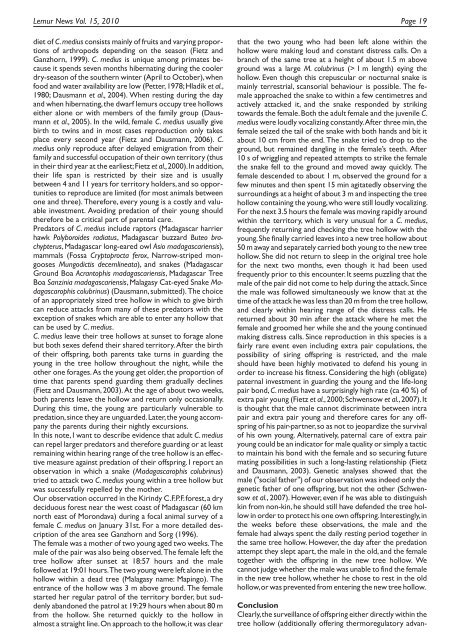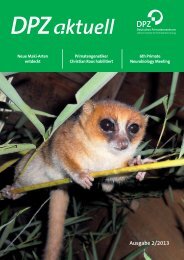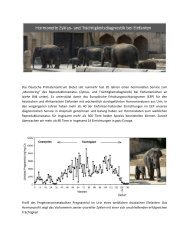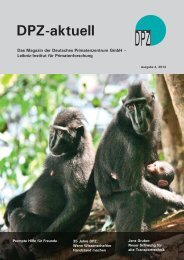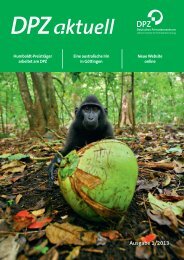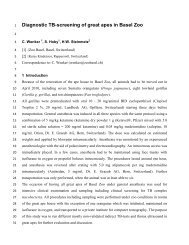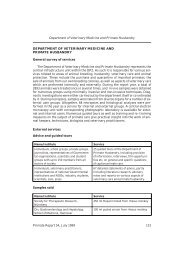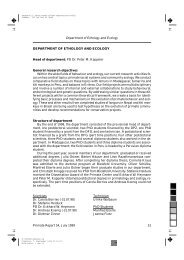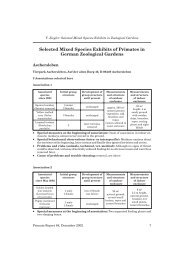Vol. 15 - Deutsches Primatenzentrum
Vol. 15 - Deutsches Primatenzentrum
Vol. 15 - Deutsches Primatenzentrum
Create successful ePaper yourself
Turn your PDF publications into a flip-book with our unique Google optimized e-Paper software.
Lemur News <strong>Vol</strong>. <strong>15</strong>, 2010 Page 19<br />
diet of C.medius consists mainly of fruits and varying proportions<br />
of arthropods depending on the season (Fietz and<br />
Ganzhorn, 1999). C. medius is unique among primates because<br />
it spends seven months hibernating during the cooler<br />
dry-season of the southern winter (April to October),when<br />
food and water availability are low (Petter,1978;Hladik et al.,<br />
1980; Dausmann et al., 2004). When resting during the day<br />
and when hibernating,the dwarf lemurs occupy tree hollows<br />
either alone or with members of the family group (Dausmann<br />
et al., 2005). In the wild, female C. medius usually give<br />
birth to twins and in most cases reproduction only takes<br />
place every second year (Fietz and Dausmann, 2006). C.<br />
medius only reproduce after delayed emigration from their<br />
family and successful occupation of their own territory (thus<br />
in their third year at the earliest;Fietz et al.,2000).In addition,<br />
their life span is restricted by their size and is usually<br />
between 4 and 11 years for territory holders, and so opportunities<br />
to reproduce are limited (for most animals between<br />
one and three). Therefore, every young is a costly and valuable<br />
investment. Avoiding predation of their young should<br />
therefore be a critical part of parental care.<br />
Predators of C. medius include raptors (Madagascar harrier<br />
hawk Polyboroides radiatus, Madagascar buzzard Buteo brachypterus,<br />
Madagascar long-eared owl Asio madagascariensis),<br />
mammals (Fossa Cryptoprocta ferox, Narrow-striped mongooses<br />
Mungodictis decemlineata), and snakes (Madagascar<br />
Ground Boa Acrantophis madagascariensis, Madagascar Tree<br />
Boa Sanzinia madagascariensis, Malagasy Cat-eyed Snake Madagascarophis<br />
colubrinus) (Dausmann,submitted). The choice<br />
of an appropriately sized tree hollow in which to give birth<br />
can reduce attacks from many of these predators with the<br />
exception of snakes which are able to enter any hollow that<br />
can be used by C. medius.<br />
C. medius leave their tree hollows at sunset to forage alone<br />
but both sexes defend their shared territory. After the birth<br />
of their offspring, both parents take turns in guarding the<br />
young in the tree hollow throughout the night, while the<br />
other one forages.As the young get older, the proportion of<br />
time that parents spend guarding them gradually declines<br />
(Fietz and Dausmann, 2003). At the age of about two weeks,<br />
both parents leave the hollow and return only occasionally.<br />
During this time, the young are particularly vulnerable to<br />
predation,since they are unguarded.Later,the young accompany<br />
the parents during their nightly excursions.<br />
In this note, I want to describe evidence that adult C. medius<br />
can repel larger predators and therefore guarding or at least<br />
remaining within hearing range of the tree hollow is an effective<br />
measure against predation of their offspring. I report an<br />
observation in which a snake (Madagascarophis colubrinus)<br />
tried to attack two C. medius young within a tree hollow but<br />
was successfully repelled by the mother.<br />
Our observation occurred in the Kirindy C.F.P.F.forest,a dry<br />
deciduous forest near the west coast of Madagascar (60 km<br />
north east of Morondava) during a focal animal survey of a<br />
female C. medius on January 31st. For a more detailed description<br />
of the area see Ganzhorn and Sorg (1996).<br />
The female was a mother of two young aged two weeks.The<br />
male of the pair was also being observed.The female left the<br />
tree hollow after sunset at 18:57 hours and the male<br />
followed at 19:01 hours.The two young were left alone in the<br />
hollow within a dead tree (Malagasy name: Mapingo). The<br />
entrance of the hollow was 3 m above ground. The female<br />
started her regular patrol of the territory border, but suddenly<br />
abandoned the patrol at 19:29 hours when about 80 m<br />
from the hollow. She returned quickly to the hollow in<br />
almost a straight line.On approach to the hollow,it was clear<br />
that the two young who had been left alone within the<br />
hollow were making loud and constant distress calls. On a<br />
branch of the same tree at a height of about 1.5 m above<br />
ground was a large M. colubrinus (> 1 m length) eying the<br />
hollow. Even though this crepuscular or nocturnal snake is<br />
mainly terrestrial, scansorial behaviour is possible. The female<br />
approached the snake to within a few centimetres and<br />
actively attacked it, and the snake responded by striking<br />
towards the female.Both the adult female and the juvenile C.<br />
medius were loudly vocalizing constantly.After three min,the<br />
female seized the tail of the snake with both hands and bit it<br />
about 10 cm from the end. The snake tried to drop to the<br />
ground, but remained dangling in the female’s teeth. After<br />
10 s of wriggling and repeated attempts to strike the female<br />
the snake fell to the ground and moved away quickly. The<br />
female descended to about 1 m, observed the ground for a<br />
few minutes and then spent <strong>15</strong> min agitatedly observing the<br />
surroundings at a height of about 3 m and inspecting the tree<br />
hollow containing the young,who were still loudly vocalizing.<br />
For the next 3.5 hours the female was moving rapidly around<br />
within the territory, which is very unusual for a C. medius,<br />
frequently returning and checking the tree hollow with the<br />
young.She finally carried leaves into a new tree hollow about<br />
50 m away and separately carried both young to the new tree<br />
hollow. She did not return to sleep in the original tree hole<br />
for the next two months, even though it had been used<br />
frequently prior to this encounter.It seems puzzling that the<br />
male of the pair did not come to help during the attack.Since<br />
the male was followed simultaneously we know that at the<br />
time of the attack he was less than 20 m from the tree hollow,<br />
and clearly within hearing range of the distress calls. He<br />
returned about 30 min after the attack where he met the<br />
female and groomed her while she and the young continued<br />
making distress calls. Since reproduction in this species is a<br />
fairly rare event even including extra pair copulations, the<br />
possibility of siring offspring is restricted, and the male<br />
should have been highly motivated to defend his young in<br />
order to increase his fitness. Considering the high (obligate)<br />
paternal investment in guarding the young and the life-long<br />
pair bond, C.medius have a surprisingly high rate (ca 40 %) of<br />
extra pair young (Fietz et al.,2000;Schwensow et al.,2007).It<br />
is thought that the male cannot discriminate between intra<br />
pair and extra pair young and therefore cares for any offspring<br />
of his pair-partner,so as not to jeopardize the survival<br />
of his own young. Alternatively, paternal care of extra pair<br />
young could be an indicator for male quality or simply a tactic<br />
to maintain his bond with the female and so securing future<br />
mating possibilities in such a long-lasting relationship (Fietz<br />
and Dausmann, 2003). Genetic analyses showed that the<br />
male ("social father") of our observation was indeed only the<br />
genetic father of one offspring, but not the other (Schwensow<br />
et al., 2007). However, even if he was able to distinguish<br />
kin from non-kin, he should still have defended the tree hollow<br />
in order to protect his one own offspring.Interestingly,in<br />
the weeks before these observations, the male and the<br />
female had always spent the daily resting period together in<br />
the same tree hollow. However, the day after the predation<br />
attempt they slept apart, the male in the old, and the female<br />
together with the offspring in the new tree hollow. We<br />
cannot judge whether the male was unable to find the female<br />
in the new tree hollow, whether he chose to rest in the old<br />
hollow,or was prevented from entering the new tree hollow.<br />
Conclusion<br />
Clearly,the surveillance of offspring either directly within the<br />
tree hollow (additionally offering thermoregulatory advan-


